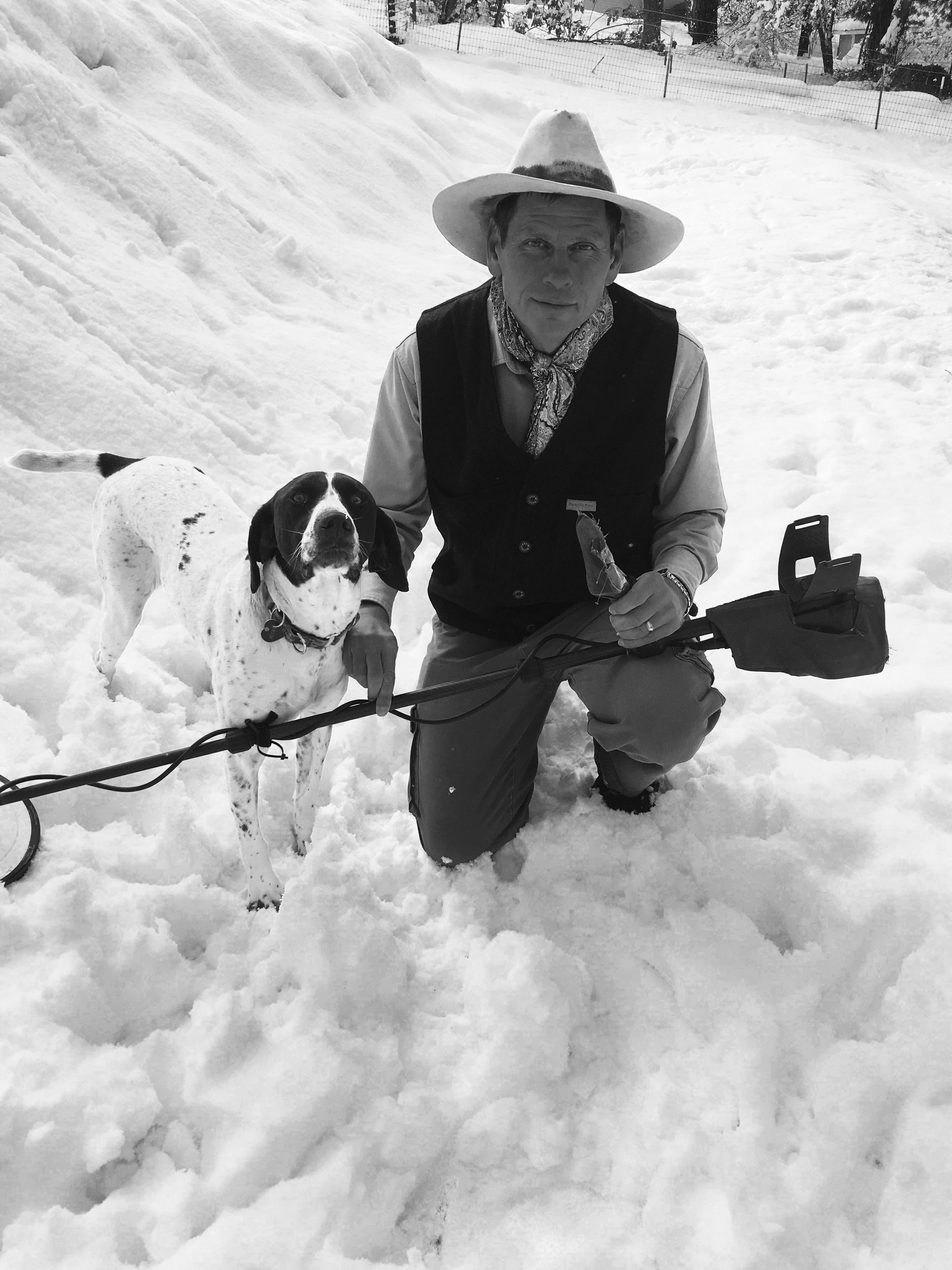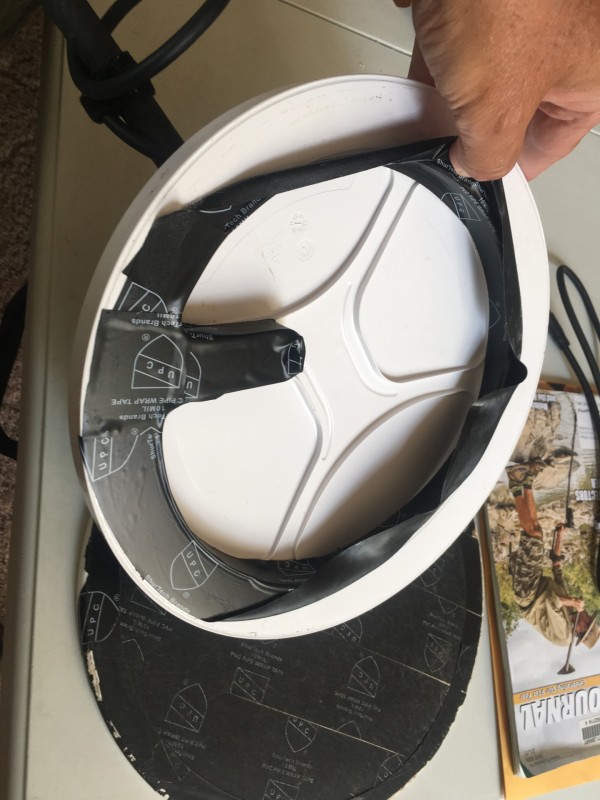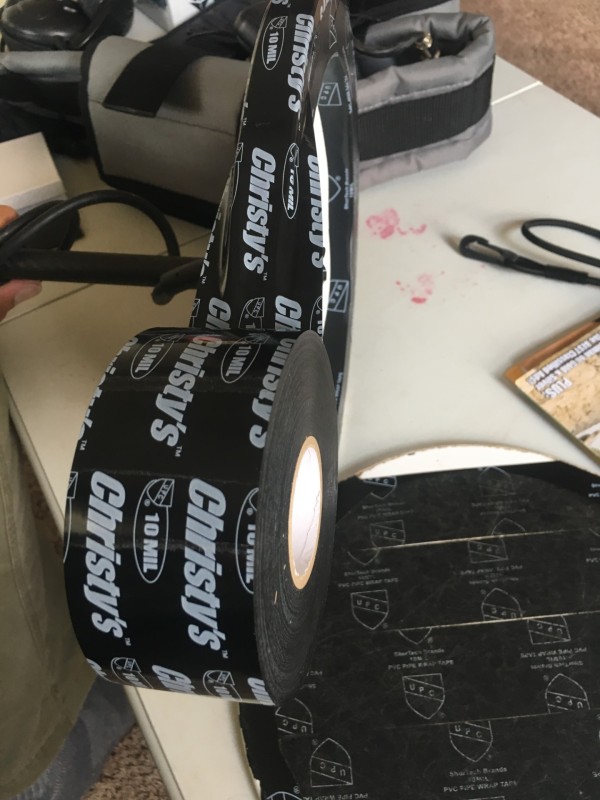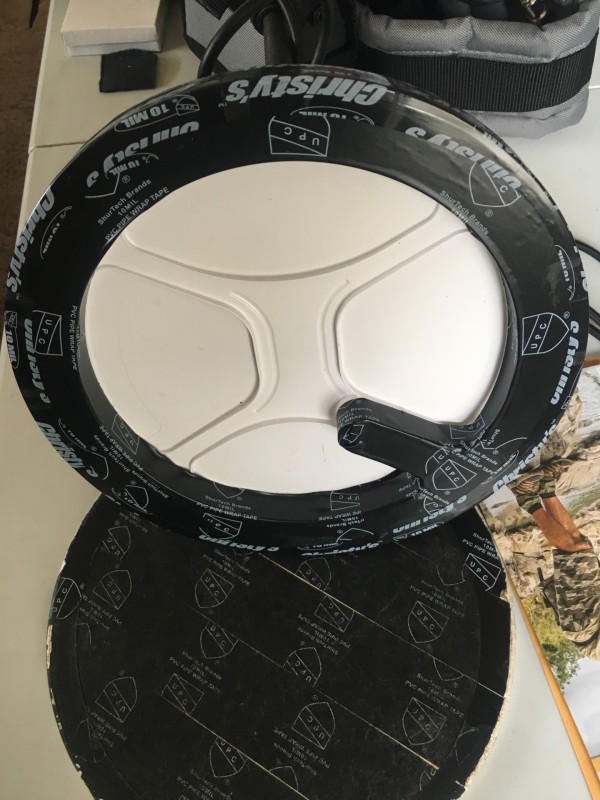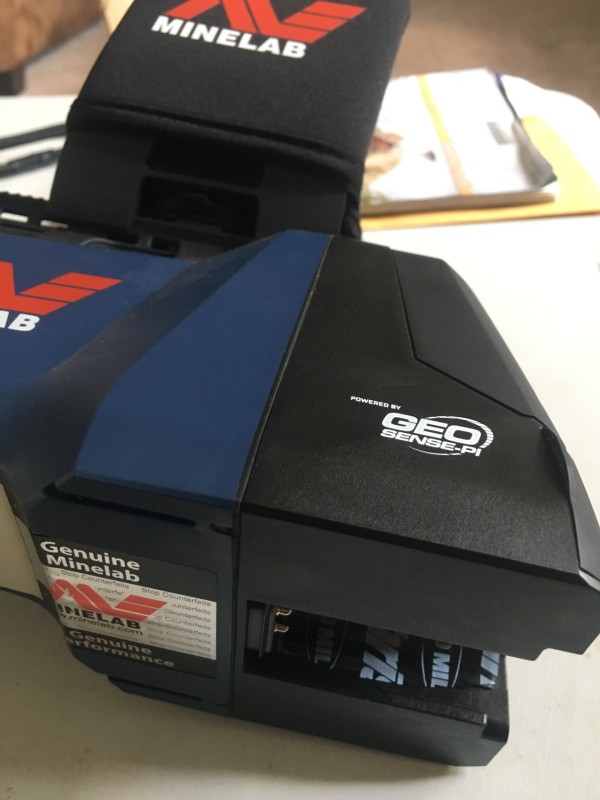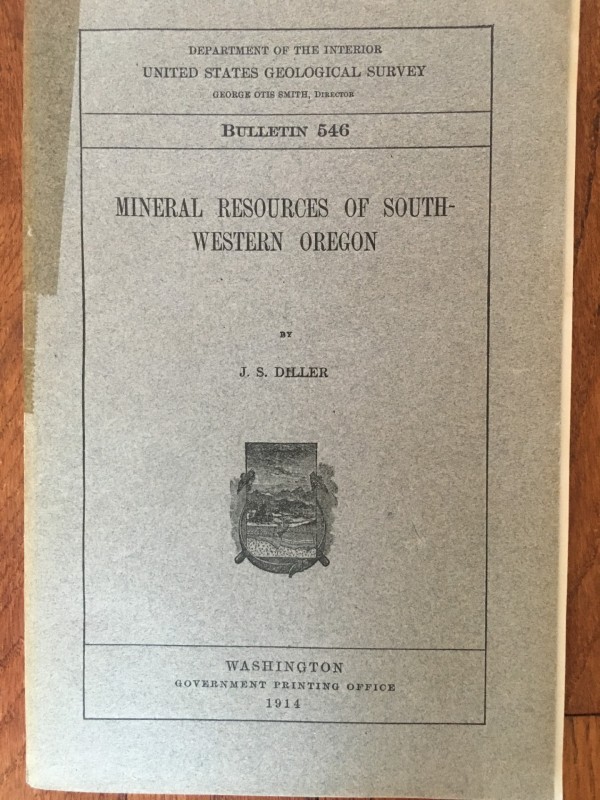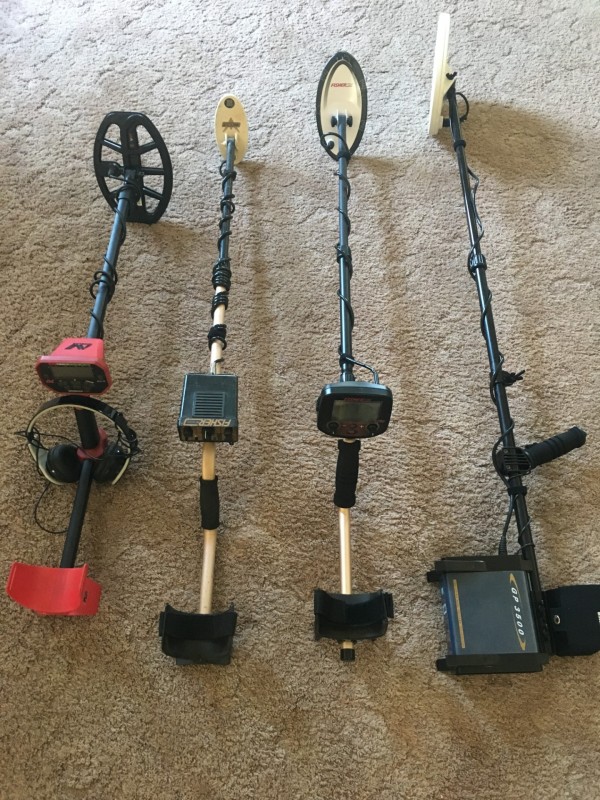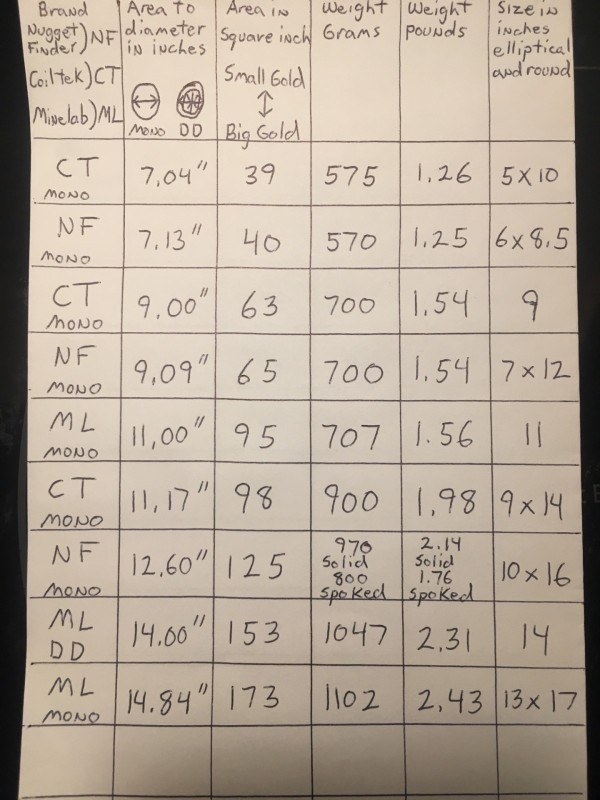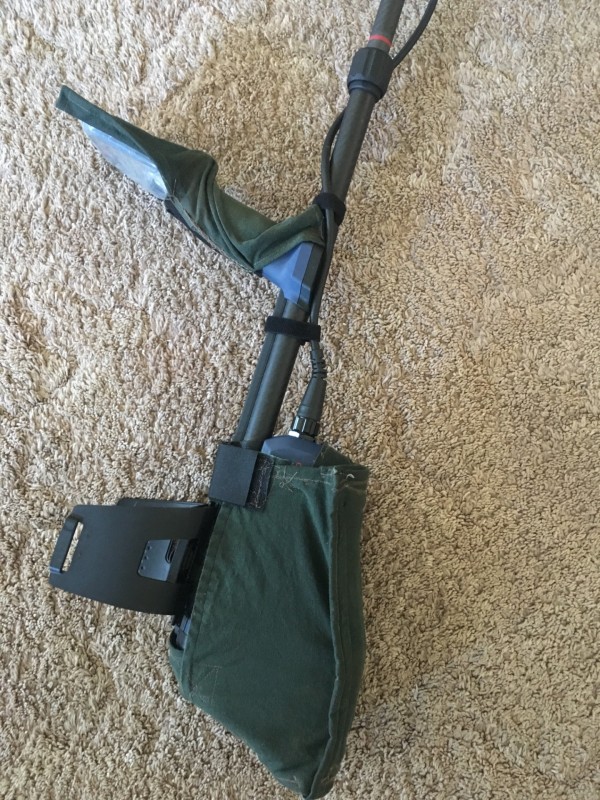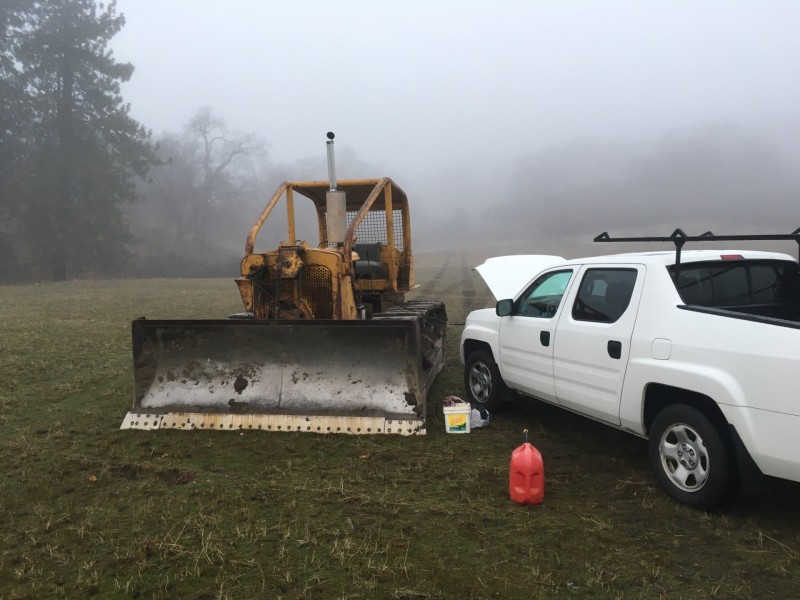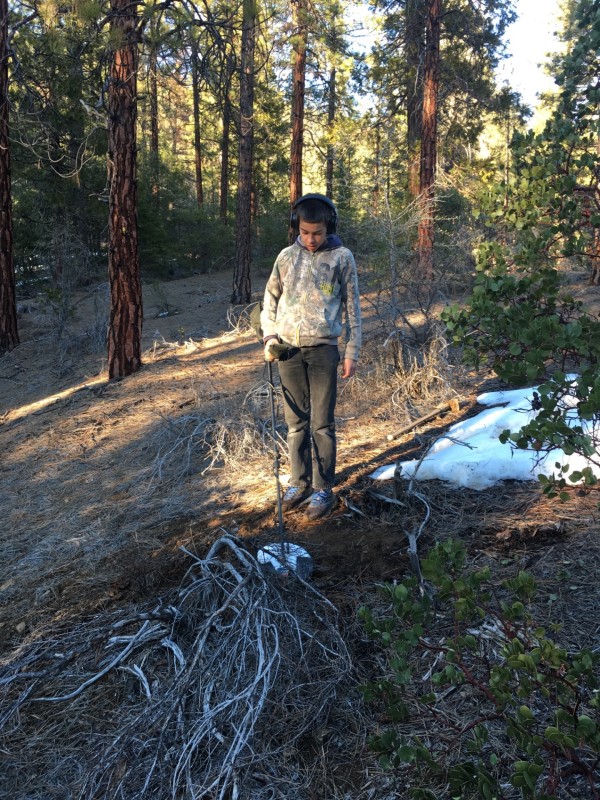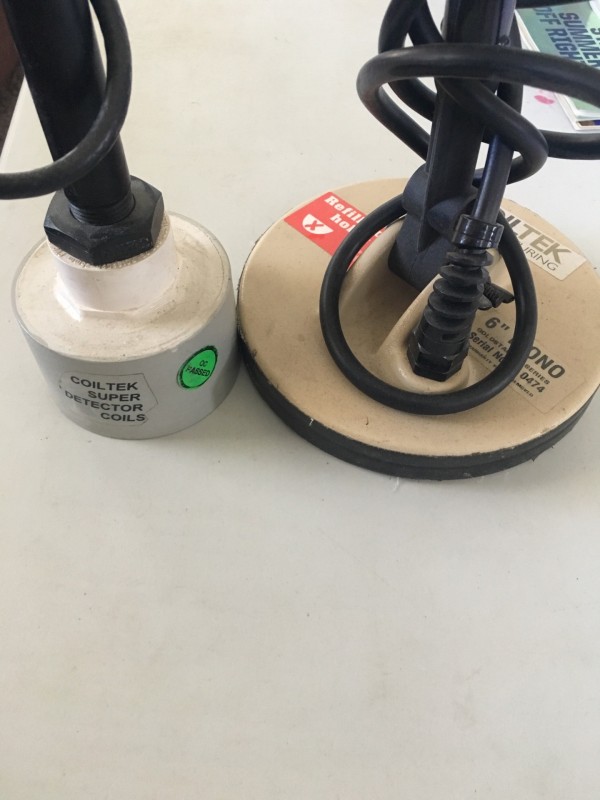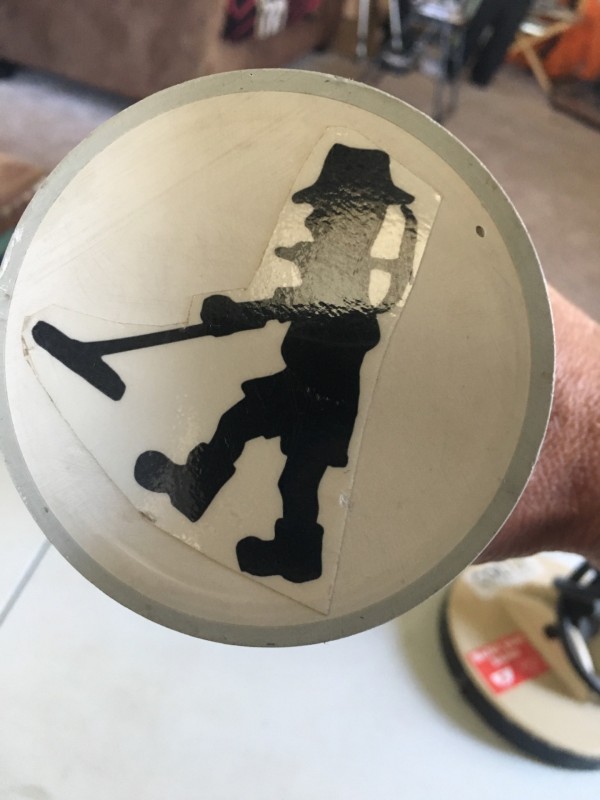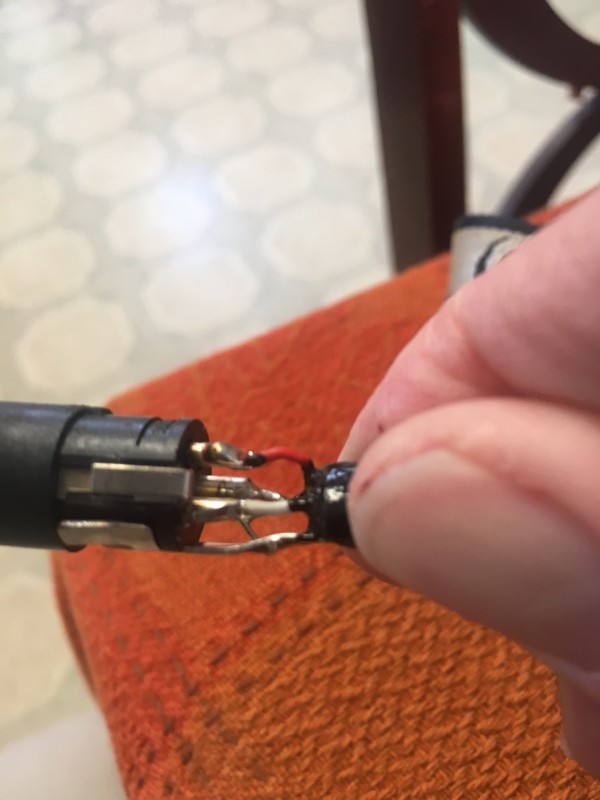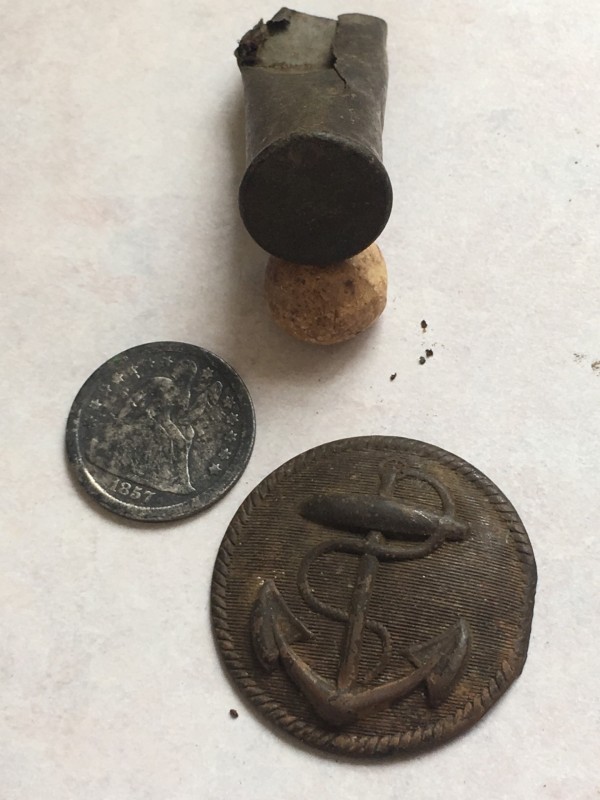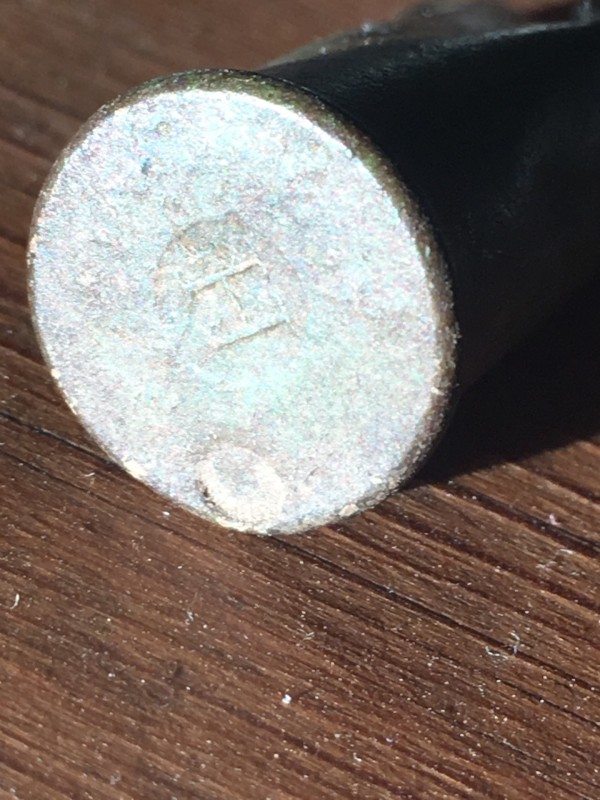-
Posts
281 -
Joined
-
Last visited
Content Type
Forums
Detector Prospector Home
Detector Database
Downloads
Everything posted by RONS DETECTORS MINELAB
-
I have been detecting with the GPX 6000 and other model detectors in creeks and rivers during the hotter summer months. The air pocket under the GPX 6000 skid plate is quite large and makes the coil act like a floating cork. The best solution I found was removing the skid plate and using UPC 2 inch 10mil. pipe wrap on the actual coil thus removing the air pocket when under water. Please see pictures! This tape is extremely scratch resistant and has great stretch ability without leaving much sticky tape residue. I have over a thousand hours detecting with the GPX 6000 using this tape without any damage to the coil. I infrequently only need to add tape to the bottom edges after a lot of coil bumping. The skid plate also fits back over the taped coil edge for when you go back to dry land detecting. I have also used a small amount of this tape to the inside of the battery compartment to tighten the loose seating of the battery. This also has prevented the exclamation warning screen from occurring when the detector is bumped hard enough or dropped. If the exclamation warning is frequent then please send it in to the repair center to be fixed correctly. Also note the accessory armrest covers in the picture. These are item # 3011-0144 Armrest Wear Kit, GPX/Sov/Eureka.-- very comfortable on the GPX 6000. Take a kid detecting. Ron
-
For those of you who plan on retiring and moving to your dream nugget detecting areas can start the research on where to go when you get there. Some of the best resources for this is the USGS Bulletins and Professional Papers from the early 1900's to present. For many years I would spend the winter days at BSU's library in Boise, Idaho. They have a complete run of the USGS reports describing the majority of the US mining districts in great detail. UNR in Reno, also host a great research library. This information I learned was so intriguing that I later became a rare book dealer for mining and geology book. Raymond Rossiter published some books in the 1870's called Mineral Resources West of the Rocky Mountains. His description of the mining conditions out west is very informative. Also my favorite writer Waldemar Lindgren wrote many mining district reports that are extremely detailed. This is a great hobby, so please enjoy the adventures and take a kid detecting.
-
Lots of people are selling their older model detectors for the newer models coming out. I guess it’s like having packrat syndrome, must have the shiny and new. This opens up a good opportunity to get some good detector prices for people on a budget. As a dealer and trainer I get asked a very good question by a lot of customers on what prospecting detector would be best for them. My answer is usually what is your price range and how mineralized is the area you planning on prospecting. If they are new to prospecting and not sure where to even go, I recommend them doing some research on the mining districts closest to them. This is best done by using the online USGS publications site or state geology sites and then by using the MLRS site to see if there is any non-claimed federal ground open to them for prospecting (U.S.A. specific). My usual recommendation for their best chance of finding nuggets is to get a PI detector when in medium to heavy mineralized ground or a VLF with a very good target VDI for low mineralized ground in rubbish littered areas. Usually the PI detectors exceeds there price limit. There are options for used PI detectors at VLF pricing, but this comes with risk by not having any warranty. I recommend only keeping a detector that’s under warranty due to the high price of repairs, but do understand there are some really good prices on used detectors also, such as the GPX-5000. The following list is just a recommendation from my experience using a majority of these detectors on what will work for nugget hunting. I am not saying price always determines the best performance due to many variables in metal detecting. This is not a debate on detector performances as it is more about what price to expect to pay to get into this hobby. All the VLF’s listed here can or should pass the bic pen sensitivity test. There are many more comparable models out there, but these were probably some of the best priced prospecting detectors I have found for the money. Detectors for light mineralization where a VLF can work well: $279,00 Minelab Vanquish 440 w 7 x 10 inch coil Multi Freq. 3 year warranty. lacks ground balance and threshold options. I recommend nugget hunting in Jewelry mode for best sensitivity. Also a multi-purpose detector. $375.00 Fisher Gold Bug newer Digital w 5 inch coil 19Khz. 5 year warranty. $449.00 Fisher F19 w 6 x 10 inch coil package. 19Khz 5 year warranty. $635.00 Nokta/Makro Legend w 6 inch coil package Multi Freq. 3 year warranty. Also a multi-purpose detector. $636.00 Nokta/Makro Gold Kruzer w 4 x 7.5 and 5.5 x 10 inch coil package 61Khz. 3 year warranty. $679 Garrett 24K w 6 x 10 inch coil 48Khz. 2 year warranty. $749.00 Fisher Gold Bug 2 analog or digital w 3 x 6.5 inch coil 71Khz. 5 year warranty. This detector is probably a specialty detector with the most sensitivity for cleaning up the smallest leftover nuggets. If you need more sensitivity then the GB2 then probably recommend the Gold Falcon MD20 pin-pointer 300Khz. $1,078.00 Minelab Equinox 800 w 6 inch coil Multi Freq. 3 year warranty. Also a multi-purpose detector. Very versatile. Many other used VLF models can come in well under $500.00, but with no warranty probably better to buy a new model for the price difference. For medium to heavy mineralization, a PI is really necessary to have the best success: Weight is usually the downside to PI detectors until the last few new releases. So weight is included on the PI list. $2,379.00 Garrett ATX w 11 x 13 inch mono coil Pulse. 2 year warranty. Great price. Weight 5.5 Lbs. $3,399.00 Minelab SDC 2300 w 8 inch mono coil Pulse. 3 year warranty. Weight 5.1 Lbs. The timings with the small 8” coil seems to handle mineralization pretty well. Very small gold capabilities. Has slight warble in threshold. $3,995.00 Garrett Axiom w 7 x 11 inch mono and 11 x 13 inch DD coils Pulse. 2 year warranty. Lowest Weight w 11 inch mono 4.25 Lbs. Great price. Waiting to hear more on the possible heavy mineralization capabilities being talked about. Very small gold capabilities. $3,999.00 Minelab GPX 5000 w 11 inch DD & 12 x 15 inch mono coils Pulse. 3 year warranty. Weight on arm minus battery pack 5.3 Lbs. with 11” coil. To be wireless you need Docs Gold Screamer pack adding some more weight. Good price. Lots to offer for coil sizes & coil configurations. $5,999.00 Minelab GPX 6000 w 11 inch mono & 14 inch DD coils Pulse. 3 year warranty. Weight 4.52 Lbs. w 11 inch mono. Very small gold capabilities. Has unstable warble in threshold using 11 inch mono coils. Headphones do help this situation. Used older Whites and Fisher PI detectors seem to hold a high value, so I usually stay away from paying a premium for them. A used GP 3500 can be found for less than $1,400, ATX for less than $1,500, GPX 4500 for less than $1,700, and GPX 5000 for less than $2,000. Most likely non warranty, but these older PI’s were built pretty solid. Heavy mineralization: $8,499.00 Minelab GPZ 7000 w 14 inch DOD coil ZVT. 3 year warranty. Weight 7.3 Lbs. NF 12 inch coil is preferred or if not worried about losing warranty then x-coils. Very small gold capabilities. Maybe Phrunt, JP, or others can describe the best options in NZ & AUS.
-
Bishop, Detecting is fine, but having a house and a pension will allow you to be able to go detecting anytime you want to. Prescott was high on my list for a great place, so the Bradshaw's sound like a dream location for beeping. Chris Gholson is also a great resource there. Lots of the northern states mentioned previously would be ideal for your RV during the late spring through early fall seasons. Deathray, Yes, Calaveras is a very nice place. Hopefully you can beach hunt in Florida with your detectors. Jasong, I'm hoping you can go camping at some of these places since your not able to move. I know of a man who goes to Mexico and detects there, last time though he was warned that the locals are getting too dangerous to be around in these mining areas. Grants Pass is a great place and is pretty close to where I live during the winter. The Klamath Mountains are full of areas to go detecting and the seasons here are fairly mild. I have not been to Durango but was considering Salida a little farther to the northwest. This town is at the foothills of the Rocky's, but has very mild weather condition in comparison to the high country. Leadville is north of Salida and is a great place for detecting. Gold Catcher, Plumas is one of those areas that we hope never gets to crowded, seems like the winters there prevent most people from moving there, so far it's still a great place for detecting. The Feather River is one of my favorite rivers. Plumas in the summer and southeastern California for the winter, not a bad idea. Not sure which town to live in as I-10 is kind of a remote area near the mining districts you mentioned. North of there is Bishop, I looked into buying real estate there years ago but there was a housing shortage and prices were too high. Luckylundy, The eastern Sierra's are a spectacular, but can be a cold place to live. I could imagine that at 5100' you have a very cold winter there. At least you can access a lot of historic mining camps in the high Sierra's and head out to northern Nevada since you are fairly close to both places. Geof_junk, I agree: Retire as soon as possible and try to keep a good home for yourself. Thanks for reminding me to try to get as much time enjoying our hobbies before age and health problems set in. Also, thanks for explaining the harsh, dangerous, and difficult conditions you have to overcome there to go detecting. I did a lot of traveling over the years to many historical mining towns. Some of my favorites were: Oregon-- Baker City area, John Day area, Sumpter, and Jacksonville area, Grants Pass area, and Durkee area. New Mexico -- Magdalina, Hillsburo, and Silver City. California -- Downieville, Mariposa, Etna, Bishop, Yreka, Nevada City, Redding, Weaverville, Georgetown, Magalia, and French Gulch. Nevada -- Winnemucca area, Virginia City, Dayton, Lovelock area, Hawthorne area, Beatty, Goldfield, Battle Mountain area, Austin, and Carson City area. Idaho -- Idaho City, Elk City, Silver City, Atlanta, and Warrens. Arizona -- Wickenburg area, Kingman area, and Prescott area, and Sedona. Alaska -- Fairbanks area and Chicken area. Montana -- Lewistown Colorado -- Georgetown
-
Retirement is probably a non-realistic option for most, in reality it's more like work till you die. But for those of you that can move to your dream prospecting area, where would you consider moving too??? I used to live hours away from my nearest mining camps which were located in Eastern Oregon and Southern Idaho, I was able to plan a few trips during the six months that they had road access due to the winter snows, in the end I realized Montana/Colorado/Northeastern Oregon/Alaska/Idaho/Wyoming/High Sierra's were probably not a good place to retire and be able to get out very often detecting, duck hunting was maybe more fit for these locations. These area's do have very remote areas that are spectacular to explore during the fair weather months and have very little people to worry about running into. I decided to try living in Winnemucca, Nevada which was probably a dream location for detecting especially in the late 90's. The changes that happened there were the big mining companies open pit mined a lot of the historical mining areas and the easy road access allowed the rest of the mining camps to get flogged with prospecting detectors. So Arizona has the opposite affect of the northern states, December is wonderful, but the summer heat is brutal, thankfully its not for six months and you can hunt in the mornings. This area has a mix of remote places and some flogged areas nearer to the snow bird camping areas. Definitely a place to consider for retirement detecting. California, hmm!!! why would you move to California, is this not the place where you make your fortune and leave as soon as possible? The southern area is surely overcrowded and has mostly private lands. The Motherload's Sierra foothills have a pretty good year around climate ideal for detecting, a lot less people to contend with and a huge amount of mining districts. The downside is lots of private ownership until you get farther into the higher Sierras', then your dealing with the winter snows as mentioned before. Northern California??? So far this place has a little of everything desirable for a retired detectorist. Lots of mining history, lots of open public lands, considerably less population, year round outdoor weather conditions (close by mountains for in the summer and the valley for when it's colder outside. Remember colder in the northern Sacramento valley is 40 degrees, not even cold if you have lived up north. I took a trip to southern New Mexico and went to Silver City and some other historical mining districts there, absolutely a beautiful place to explore. It also includes a lot of the qualities of northern California. I have not been to NZ, WA or other places like that. Maybe someone from there could better describe the places they have found there dream detecting place. Or maybe they do not want to attract attention to it, which makes good sense to keep it a secret.
-
Geotech, IMHO For the professional prospector definitely manual GB. For the newer prospectors or patch hunters on widely variable mineralized ground, less noise is preferable until they get more comfortable with the different sounds, so tracking GB would be best. New detector users like more simplicity, so to expand your market to both types of users will be probably better accomplished by having both options available at some point in time. For now I would suggest do what Minelab does by starting with a new model dectector, then in two years add a couple of better options to re-up sales again. This will get the detector to the market sooner and give you time to fine tune the tracking GB for the next release. So glad to hear this detector can compare to the SDC’s performance, hopefully the price and weight will be better too, I’d pay even more if it has some decent discrimination also. Can you describe the discrimination abilities on this new detector? Thank You, Ron
-
The chart shows current GPX-6000 coil sizes, weights, and areas. I hope this chart can help you find out which coil to bye in the future. Phrunt- the 6 X 8.5 specifics have been added to the chart.
-
Gerry, I believe other manufacturers might come out with a good PI once Minelabs PI patents expire, might even be under $2,000 for these detectors at that point. Minelab is paving the way on technology and a lighter weight Zero Voltage Geo-sense with CTX 4040 imagery would make the goldfields come alive again, hopefully this will occur within my lifetime. The last 8 years has had some amazing electronic engineering breakthroughs on metal detectors though. The picture is of a new Apex digger tool needed for your 5’ holes you’ll be digging with your higher performance GPZ replacement. 🤔
-
As a Minelab dealer I’m always looking for a new and better King, so I am hoping the GPZ 8000 makes the 6000/7000 a dead king soon.😬 The GPX 6000 is more of a Queen, as it can multitask with all its timings and its ergonomics are very pleasant to handle. I think the 6000 is the lightest pulse induction out there with excellent performance. For the most part, the 6000 is the best detector for me due to the performance, weight, and the price. The Prince is still the waterproof version of pulse induction detectors that lack the performance of the latter two detectors, but can be used in water flowing areas. Happy Fathers Day, hope you’re out swinging soon. Take a kid detecting with the GPX6000
-
Smallest Coil For GPX 5000?
RONS DETECTORS MINELAB replied to mn90403's topic in Minelab Metal Detectors
I wish these small sniping coils were available with all their PI Detector’s. I’m not sure when these were in production or why they stopped making these, seems like there would be a huge market for them.- 46 replies
-
- 3
-

-
Smallest Coil For GPX 5000?
RONS DETECTORS MINELAB replied to mn90403's topic in Minelab Metal Detectors
The smallest Coiltek GPX coil I have is the 3 inch mono, I’m not sure when this coil was made but do not believe they have been made for quite some time now. This coil is a super convenient coil for sniping bedrock crevices, hope they make one for current and future pi’s.- 46 replies
-
- 5
-

-
Shortening Gold Bug 2 Cable
RONS DETECTORS MINELAB replied to Detectorist Dan's topic in Detector Prospector Forum
It can be done, but the wires are very small and hard to solder back on. I had to fix several older coils with shrink wrap after the rubber coating became brittle and separated, so I had to take the connector off. You should use plastic dip also too keep the wires from twisting and shorting. -
Merry Christmas - Hohoho
RONS DETECTORS MINELAB replied to phrunt's topic in Detector Prospector Forum
Merry Christmas to all and thanks for everyone’s contribution to this DP forum, top notch. Ron’s Detector ‘s -
Well, I Had A Nice Day!
RONS DETECTORS MINELAB replied to nebulanoodle's topic in Detector Prospector Forum
Wow, that would be a day to remember for sure, glad you did so well. Ron -
Pin Pointing With The 11” Coil
RONS DETECTORS MINELAB replied to billdean's topic in Detector Prospector Forum
I have to use the GPX coil sticker on smaller targets as the edge of the coil is not able to hear small faint signals. On larger targets the already mentioned above works pretty good. I would also add I use the Pro-find 35 pinpointer on larger targets when I do not bring the Gold Bug 2 along. This pinpointer has a few learning challenges, but is very sensitive on 3 grain nuggets and a lot more so on larger targets saving me a lot of time and energy in locating targets and not having to lift up a 4.6 pound detector multiple times to locate a target. I felt I paid for my Pro-find 35 the first two days using it. Ron’s Detector’s -
The King Of Detectors Has Spoken
RONS DETECTORS MINELAB replied to Gerry in Idaho's topic in Detector Prospector Forum
Gerry, Add 40% deeper to the GPX 6000 and there would only be one detector ever needed for placer gold, call it the gold vacuum. This detector is way better than I ever imagined the GoldBug 3 could of possibly been except for discrimination.👑 Nice job with the finds! Ron’s Detector ‘s -
Felix arami, thanks for your response. yes, I would agree that Doc really came up with the best bungee systems that I’ve encountered so far. The longer lower shaft will also help taller people by allowing the bungee to be more forward on the shaft, in return helping to keep it from hitting the control pad so much. My post goal here is to figure out how to get more hours in a day detecting, lately been feeling the shoulder and back feeling sore after two days back to back detecting.

